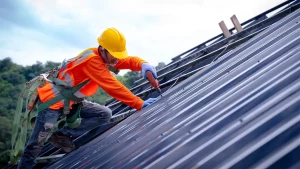Ideal humidity levels are crucial in construction, especially when it comes to roofing. Moisture can silently damage roofs over time, jeopardizing their protective function. Understanding how humidity affects roofing materials is key to ensuring their longevity and performance. By delving into the intricate link between humidity and roofs, we uncover vital strategies for safeguarding against moisture’s harmful effects. Stay tuned to discover how to protect roofs from humidity’s stealthy impact.
Key Takeaways
- Excessive humidity can lead to mold growth and material deterioration.
- Proper ventilation prevents moisture buildup, enhancing roofing durability.
- Humidity control techniques like vapor barriers prevent condensation issues.
- Addressing humidity ensures structural integrity and prolongs material lifespan.
- Effective moisture management is essential for long-term roofing performance.
The Impact of Humidity on Roofing Materials
Impact of humidity on roofing plays a vital role in influencing the durability and performance of roofing materials in construction projects. Excessive moisture levels can lead to the deterioration of materials, causing issues such as mold growth, rotting, and corrosion. Understanding how humidity impacts roofing materials is important for selecting the appropriate materials and implementing effective moisture control strategies to guarantee the longevity and effectiveness of the roof system.
How Humidity Affects Roofing Durability
The impact of moisture levels on the durability of roofing materials is a critical factor to take into account in construction projects. High humidity levels can lead to the deterioration of roofing materials over time. Excessive moisture can weaken the structural integrity of the roof, causing issues such as mold growth, rotting, and corrosion. Proper ventilation and moisture control measures are essential to enhance the longevity of roofing systems.
Preventing Moisture-Related Roofing Issues
To mitigate potential moisture-related issues in roofing systems, implementing proactive strategies for moisture control is imperative in ensuring the long-term durability and performance of the structure. Proper ventilation, effective insulation, and regular maintenance are key components in preventing moisture infiltration, condensation, and subsequent damage to roofing materials. Moisture management practices should be integrated into the overall roofing system design to enhance its resilience against environmental factors.
Humidity Control Techniques for Roofing
Effectively managing moisture levels within roofing systems is crucial for ensuring their longevity and structural integrity in various environmental conditions. Humidity control techniques for roofing include proper ventilation systems, vapor barriers, and insulation to prevent condensation buildup. Monitoring indoor humidity levels and utilizing dehumidifiers can also contribute to maintaining an ideal environment for the roof structure, reducing the risk of moisture-related issues.
Ensuring Longevity Through Humidity Management
Proper management of humidity levels plays an important role in ensuring the long-term durability and performance of roofing systems.
Key Aspects of Longevity Through Humidity Management:
- Implementing effective ventilation systems to control moisture buildup.
- Utilizing moisture barriers to prevent water infiltration.
- Regular monitoring and maintenance to address any humidity-related issues promptly.
Frequently Asked Questions
How Does Humidity Impact the Energy Efficiency of a Building’s Roofing System?
Humidity can compromise a building’s roofing system by promoting mold growth, reducing insulation effectiveness, and accelerating material degradation. These factors collectively lead to decreased energy efficiency, higher cooling costs, and potential structural issues.
Can High Humidity Levels Lead to Mold and Mildew Growth on Roofs?
High humidity levels can indeed lead to mold and mildew growth on roofs. This is due to the excess moisture present, creating an ideal environment for such fungal growth. Proper ventilation and moisture control are essential to prevent this issue.
What Are the Signs of Humidity-Related Damage on Roofing Materials?
Signs of humidity-related damage on roofing materials include mold growth, water stains, peeling paint, and rotting wood. These issues can compromise the structural integrity of the roof and should be promptly addressed to prevent further damage.
Is Ventilation Essential for Controlling Humidity in Roofing Systems?
Ventilation is essential for controlling humidity in roofing systems. Proper airflow helps prevent moisture buildup, reducing the risk of mold, rot, and structural damage. Implementing effective ventilation strategies guarantees a healthier and more durable roofing system in construction projects.
How Does Humidity Affect the Performance of Different Types of Roofing Materials?
Humidity can impact the performance of various roofing materials. Excessive moisture can lead to mold growth, corrosion, and decreased insulation effectiveness. Understanding how different materials interact with humidity is essential for choosing durable and efficient roofing solutions.
Conclusion
To sum up, addressing humidity in construction is essential for ensuring the durability and longevity of roofing materials. By implementing effective moisture control strategies, such as proper ventilation, insulation, and moisture barriers, construction professionals can prevent moisture-related issues that compromise the structural integrity of roofs. Managing humidity levels not only enhances the overall quality and performance of roofing systems but also contributes to the sustainability and resilience of construction projects.




